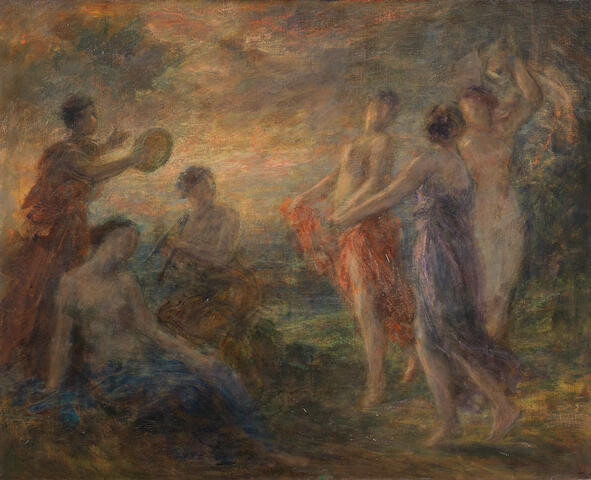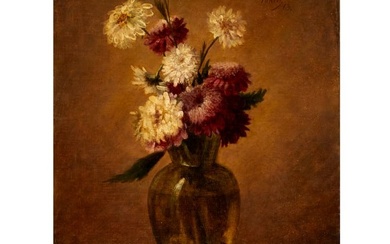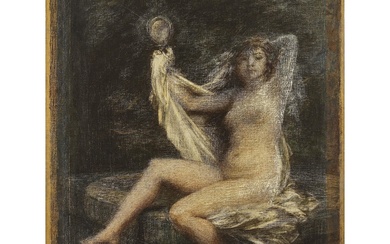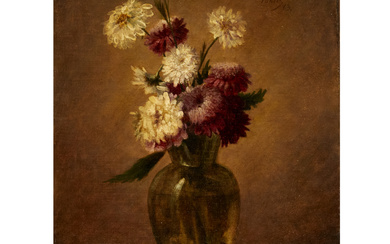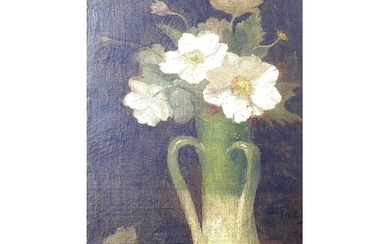Henri Fantin-Latour, (French, 1836-1904)
Danses au soir
Danses au soir
bears signature (lower right)
oil on canvas
73.7 x 91.5cm (29 x 36in).
Painted circa 1904
We are grateful to Galerie Brame & Lorenceau for confirming the authenticity of the present lot, which will be included in the Catalogue raisonné des peintures et pastels de Fantin-Latour, currently in preparation.
Provenance
Mme. Fantin-Latour, Paris.
Ferdinand Tempelaere, Paris.
Jean Tempelaere, Paris.
Anon. sale, Palais Galliera, Paris, 14 March 1969, lot 37.
E.J. Van Wisselingh & Co, Amsterdam.
Private collection, Netherlands.
Exhibited
Grenoble, Musée Bibliothèque de Grenoble, Centenaire de Henri Fantin-Latour, August - October 1936, no. 94.
Literature
Mme. Fantin-Latour, Catalogue de l'oeuvre complet de Fantin-Latour, 1849-1904, Paris, 1911, no. 2165, p. 228 (listed with inverted measurements).
Through a series of dream-like compositions, using elegant female forms to represent personifications of Dawn, Day and Night, Fantin-Latour's fantasies stand alongside such Symbolist masters as Gustave Moreau, Odilon Redon and Puvis de Chavannes. Many of Fantin-Latour's figurative and symbolist works were executed towards the end of his distinguished career, when his reputation as a floral still-life painter was well established. In paintings such as Immortalitie (1889, National Museum of Wales, Cardiff), L'Aurore et La Nuit (1894, Birmingham Museum and Art Gallery) and La Nuit (sold in these rooms 2 March 2016, lot 72), Fantin-Latour creates elegant allegories loosely drawn from mythology, female figures nestled among the clouds. Fantin-Latour, like many of the Symbolist painters, also drew inspiration from music; see for example Tannhäuser on the Venusberg (1864, Los Angeles County Museum of Art), which took its subject from a Wagner opera.
In Danses au soir which, like La Nuit passed through the hands of the distinguished Amsterdam dealers E. J. van Wisselingh & Co., Fantin-Latour depicts six elegant female figures, perhaps the Muses, revelling in a twilight landscape; three figures dance to the musical accompaniment of a tambourine and double flute, instruments generally associated with Euterpe, the muse of music and lyric poetry, and Erato, the muse of lyric and love poetry. The colourful robes draped around the figures call to mind the symbolic figures of Dawn and Night in L'aurore et la nuit, set against the reddening sky.
View it on
Estimate
Time, Location
Auction House
Danses au soir
Danses au soir
bears signature (lower right)
oil on canvas
73.7 x 91.5cm (29 x 36in).
Painted circa 1904
We are grateful to Galerie Brame & Lorenceau for confirming the authenticity of the present lot, which will be included in the Catalogue raisonné des peintures et pastels de Fantin-Latour, currently in preparation.
Provenance
Mme. Fantin-Latour, Paris.
Ferdinand Tempelaere, Paris.
Jean Tempelaere, Paris.
Anon. sale, Palais Galliera, Paris, 14 March 1969, lot 37.
E.J. Van Wisselingh & Co, Amsterdam.
Private collection, Netherlands.
Exhibited
Grenoble, Musée Bibliothèque de Grenoble, Centenaire de Henri Fantin-Latour, August - October 1936, no. 94.
Literature
Mme. Fantin-Latour, Catalogue de l'oeuvre complet de Fantin-Latour, 1849-1904, Paris, 1911, no. 2165, p. 228 (listed with inverted measurements).
Through a series of dream-like compositions, using elegant female forms to represent personifications of Dawn, Day and Night, Fantin-Latour's fantasies stand alongside such Symbolist masters as Gustave Moreau, Odilon Redon and Puvis de Chavannes. Many of Fantin-Latour's figurative and symbolist works were executed towards the end of his distinguished career, when his reputation as a floral still-life painter was well established. In paintings such as Immortalitie (1889, National Museum of Wales, Cardiff), L'Aurore et La Nuit (1894, Birmingham Museum and Art Gallery) and La Nuit (sold in these rooms 2 March 2016, lot 72), Fantin-Latour creates elegant allegories loosely drawn from mythology, female figures nestled among the clouds. Fantin-Latour, like many of the Symbolist painters, also drew inspiration from music; see for example Tannhäuser on the Venusberg (1864, Los Angeles County Museum of Art), which took its subject from a Wagner opera.
In Danses au soir which, like La Nuit passed through the hands of the distinguished Amsterdam dealers E. J. van Wisselingh & Co., Fantin-Latour depicts six elegant female figures, perhaps the Muses, revelling in a twilight landscape; three figures dance to the musical accompaniment of a tambourine and double flute, instruments generally associated with Euterpe, the muse of music and lyric poetry, and Erato, the muse of lyric and love poetry. The colourful robes draped around the figures call to mind the symbolic figures of Dawn and Night in L'aurore et la nuit, set against the reddening sky.
